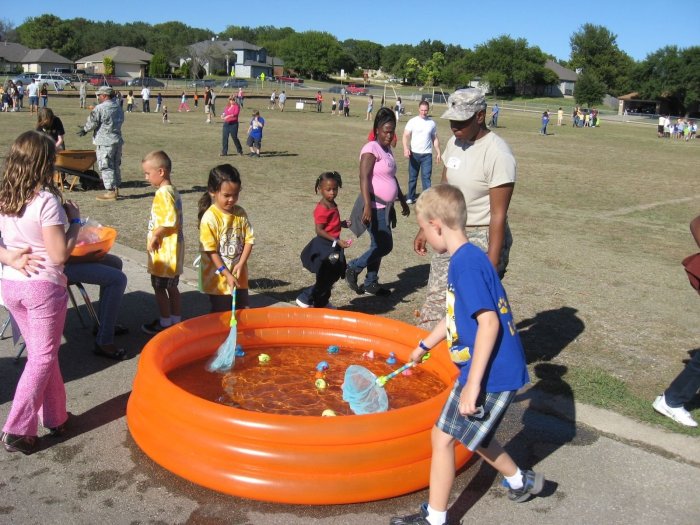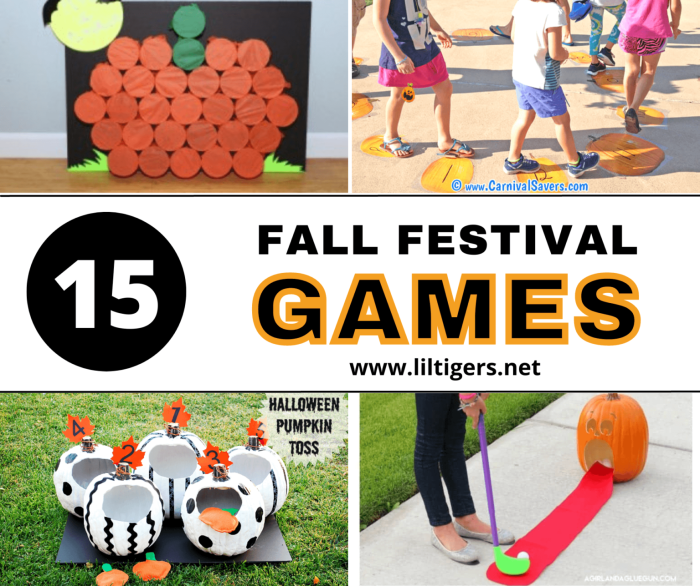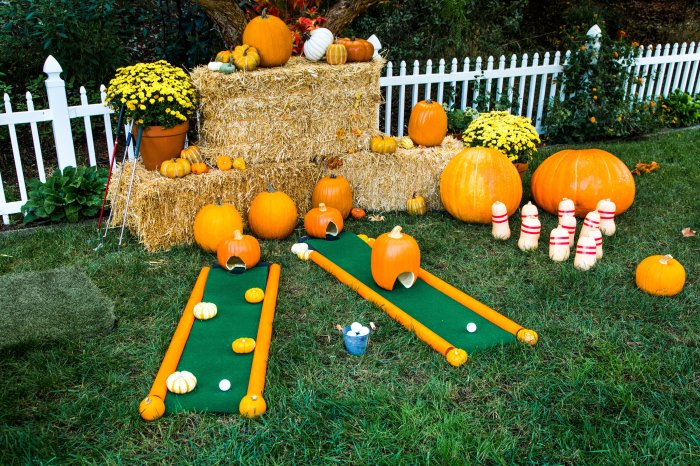Fall Festival Game Ideas: Want to create a fall festival that’s unforgettable? Forget the same old tired games. This isn’t just about bobbing for apples; it’s about crafting an experience that captivates your audience, from kids to adults. We’re diving deep into innovative game themes, modern twists on classics, and entirely original ideas to make your festival the talk of the town.
Get ready to transform your event into a vibrant autumnal spectacle filled with fun, engaging activities, and lasting memories.
We’ll explore diverse game mechanics, crafting a tiered prize system that keeps everyone motivated. From setting up your game booths to managing the flow of participants, we’ll cover everything you need to ensure a seamless and enjoyable experience for everyone involved. This isn’t just about games; it’s about creating a winning festival strategy.
Creative Fall Festival Game Ideas

Fall festivals offer a fantastic opportunity to engage attendees of all ages with fun and memorable activities. By incorporating the spirit of autumn and leveraging readily available materials, you can create engaging games that boost participation and leave a lasting positive impression. The key is to design games that are inclusive, easy to understand, and aligned with the festive atmosphere.
Five Original Fall Festival Games
Below, we present five original game ideas designed specifically to capitalize on the unique ambiance of a fall festival. Each game is meticulously detailed, outlining rules, gameplay, necessary materials, and the ideal target audience. This ensures maximum engagement and enjoyment for all participants.
| Game Name | Description | Materials Needed | Target Audience |
|---|---|---|---|
| Pumpkin Ring Toss | Players toss rings (made from rope or twine) onto pumpkins of varying sizes placed at different distances. Points are awarded based on the size of the pumpkin and the accuracy of the toss. A leaderboard can add to the competitive spirit. | Pumpkins of varying sizes, rope or twine to make rings, scoring system (chalkboard or printed sheet). | All ages |
| Leaf Pile Leap Frog | Create several designated leaf piles of varying heights. Participants compete to leap frog over the piles in a timed race. Safety precautions, such as soft landing areas, are essential. | Large quantities of fallen leaves, timers (stopwatches or phones), designated starting and finishing lines. | Children (with adult supervision for younger children) |
| Corn Maze Challenge | A mini corn maze (easily created using potted corn stalks or even cardboard cutouts) challenges players to navigate their way to the center within a time limit. Adding riddles or clues along the way enhances the complexity and engagement. | Potted corn stalks or cardboard cutouts to create a maze, timer, clues or riddles (optional). | All ages |
| Apple Bobbing Relay Race | Teams compete in a relay race where each member must retrieve an apple from a tub of water using only their mouth. This classic game is always a crowd-pleaser, especially with a competitive twist. | Several large tubs filled with water, apples, towels. | Children and adults (separate categories recommended) |
| Pin the Stem on the Pumpkin | A variation on the classic “Pin the Tail on the Donkey,” this game uses a large pumpkin drawing and smaller stem cutouts. Blindfolded players try to pin the stem onto the pumpkin. The closest to the correct spot wins. | Large pumpkin drawing (printed or drawn), smaller stem cutouts, blindfolds, pins. | Children |
Fall Festival Game Prizes & Rewards

A well-designed prize system is crucial for the success of any fall festival. It incentivizes participation, fosters a sense of friendly competition, and leaves attendees with positive memories. A thoughtfully crafted reward structure isn’t just about giving away prizes; it’s about enhancing the overall experience and aligning with the festival’s theme. This involves careful consideration of prize tiers, non-monetary options, and fairness.A tiered prize system allows for varying levels of achievement and engagement, catering to a broader range of participants.
This approach ensures everyone has a chance to win something, regardless of their skill level or participation time. A simple, yet effective, system ensures a smooth and rewarding experience for all.
Tiered Prize System for a Fall Festival, Fall Festival Game Ideas
This system uses three tiers to reward participants based on their performance in various games. The prizes are designed to be appealing to a wide age range and reflect the fall season.
- Bronze Tier (Participation Award): Awarded to all participants who complete at least one game. Prizes could include small bags of candy corn, pumpkin-shaped stickers, or a small bag of fall-themed seeds for planting. This ensures everyone feels appreciated for their involvement. This tier focuses on participation and inclusion, making it appealing to a broad audience.
- Silver Tier (Mid-Level Achievement): Awarded to participants who achieve a specific score or complete a set number of challenges within a game. Prizes could include a small pumpkin pie, a fall-themed mug, or a voucher for a discount at a local farm stand. This tier adds an element of competition, motivating players to strive for better results. The prizes offer a step up from the bronze tier, rewarding those who dedicate more time and effort.
- Gold Tier (Top Performer): Awarded to the top performer(s) in each game. Prizes could include a gift basket filled with gourmet fall treats, a family pass to a local orchard or pumpkin patch, or a handcrafted fall-themed item like a scarecrow or a decorative gourd. This tier acknowledges exceptional performance and creates a memorable experience for the winners. The higher-value prizes act as strong incentives for competitive players.
Non-Monetary Prizes Aligned with the Fall Theme
Beyond traditional prizes, incorporating non-monetary rewards enhances the fall festival’s charm and sustainability. These prizes offer unique experiences and create lasting memories.
- Experiences: Tickets to a local fall festival event, a guided nature walk through a nearby park showcasing fall foliage, or a pottery class focused on fall-themed designs. These experiences create lasting memories and support local businesses.
- Handmade Items: Hand-knitted scarves, hand-painted pumpkins, homemade jams or preserves, or fall-themed artwork. These personalized gifts offer a unique touch and showcase local talent.
- Charitable Donations: In lieu of a prize, participants can choose to donate to a local charity in their name. This option promotes community engagement and supports a worthy cause.
Creating a Fair and Engaging Prize System
Fairness and engagement are paramount to a successful prize system. Transparency is key; clearly outlining the rules, scoring systems, and prize structure before the games begin prevents misunderstandings and ensures everyone understands the parameters of competition. The prizes should be distributed fairly and consistently, based on pre-determined criteria. Furthermore, the prizes should be appealing and relevant to the target audience.
Consider factors like age, interests, and cultural preferences when selecting prizes to ensure broad appeal and engagement. A well-designed prize system will leave participants feeling satisfied and excited about future events.
Setting Up & Managing Fall Festival Games: Fall Festival Game Ideas

Successfully running a fall festival game booth requires meticulous planning and execution. From securing the right space to managing participant flow, every detail impacts the overall experience and ultimately, your festival’s success. A well-organized game booth not only generates excitement but also contributes to a positive and memorable event for attendees.
Space Requirements and Logistical Considerations
Determining the appropriate space for your game booth is crucial. Consider the number of games you plan to offer, the anticipated participant volume, and the necessary space for queuing, prize distribution, and staff movement. A cramped space can lead to bottlenecks and frustration, while excessive space might seem underutilized. Aim for a balance. For example, a booth offering three games might require a minimum of 20 feet by 10 feet, allowing for roughly 7 feet per game plus space for walkways and a prize table.
Remember to factor in accessibility considerations, ensuring ample room for wheelchairs and strollers to navigate comfortably. Logistical elements like power access for any electronic games, stable surfaces for game setups, and adequate lighting should be confirmed well in advance. Secure necessary permits and insurance well in advance to avoid last-minute complications.
Managing Game Flow and Ensuring a Smooth Experience
Efficient game flow is paramount to preventing long lines and keeping participants engaged. Clearly defined queues with signage indicating wait times can help manage expectations. Consider using a ticketing system or numbered tokens to streamline the process. Staff should be adequately trained on game rules, prize distribution, and handling potential issues efficiently. Employing a system of rotating staff can prevent burnout and maintain consistent service.
Regularly monitor queue lengths and adjust staffing levels as needed to ensure minimal wait times. Consider offering different game options catering to various age groups and skill levels to ensure broader participation. For example, a simple ring toss could appeal to younger children, while a more complex bean bag toss might attract older participants.
Managing a Large Number of Participants
Handling a large influx of participants requires a robust strategy. Pre-festival promotion and publicity can help manage expectations and distribute participant load across the festival duration. Implementing a timed-entry system for popular games, similar to a theme park ride, can prevent overcrowding and maintain a controlled flow. Having backup games or activities ready can help divert participants if one game becomes excessively popular.
Consider using a volunteer team to assist with queue management, prize distribution, and general crowd control. Clear communication is key; use signage and announcements to keep participants informed about wait times and any changes in the game schedule. Having contingency plans in place for unexpected surges in attendance, such as additional staff or alternative game locations, is essential for maintaining a smooth and enjoyable experience for all.
Planning a successful fall festival requires more than just pumpkins and hayrides. By implementing creative game ideas, adapting traditional games, and designing a compelling prize system, you can significantly enhance the overall experience for attendees. Remember, the key is engagement—creating games that appeal to diverse age groups and skill levels. This guide provides the framework for a memorable fall festival, turning a simple event into a highly successful and engaging experience that people will rave about for years to come.
Don’t just host a festival; create an unforgettable event.